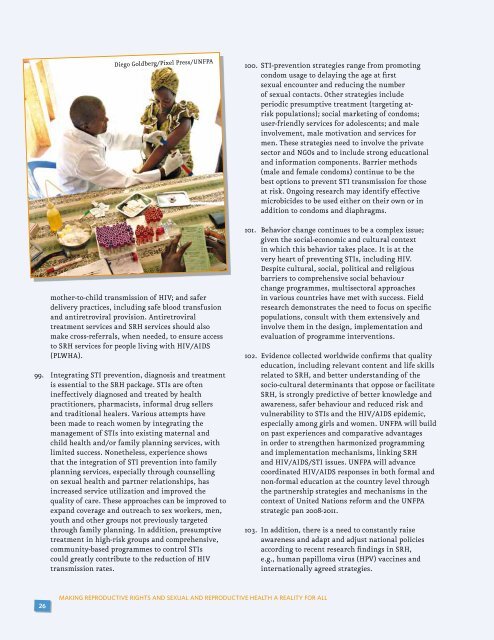Sexual and Reproductive Health Framework - UNFPA
Sexual and Reproductive Health Framework - UNFPA
Sexual and Reproductive Health Framework - UNFPA
Create successful ePaper yourself
Turn your PDF publications into a flip-book with our unique Google optimized e-Paper software.
Diego Goldberg/Pixel Press/<strong>UNFPA</strong>mother-to-child transmission of HIV; <strong>and</strong> saferdelivery practices, including safe blood transfusion<strong>and</strong> antiretroviral provision. Antiretroviraltreatment services <strong>and</strong> SRH services should alsomake cross-referrals, when needed, to ensure accessto SRH services for people living with HIV/AIDS(PLWHA).99. Integrating STI prevention, diagnosis <strong>and</strong> treatmentis essential to the SRH package. STIs are oftenineffectively diagnosed <strong>and</strong> treated by healthpractitioners, pharmacists, informal drug sellers<strong>and</strong> traditional healers. Various attempts havebeen made to reach women by integrating themanagement of STIs into existing maternal <strong>and</strong>child health <strong>and</strong>/or family planning services, withlimited success. Nonetheless, experience showsthat the integration of STI prevention into familyplanning services, especially through counsellingon sexual health <strong>and</strong> partner relationships, hasincreased service utilization <strong>and</strong> improved thequality of care. These approaches can be improved toexp<strong>and</strong> coverage <strong>and</strong> outreach to sex workers, men,youth <strong>and</strong> other groups not previously targetedthrough family planning. In addition, presumptivetreatment in high-risk groups <strong>and</strong> comprehensive,community-based programmes to control STIscould greatly contribute to the reduction of HIVtransmission rates.100. STI-prevention strategies range from promotingcondom usage to delaying the age at firstsexual encounter <strong>and</strong> reducing the numberof sexual contacts. Other strategies includeperiodic presumptive treatment (targeting atriskpopulations); social marketing of condoms;user-friendly services for adolescents; <strong>and</strong> maleinvolvement, male motivation <strong>and</strong> services formen. These strategies need to involve the privatesector <strong>and</strong> NGOs <strong>and</strong> to include strong educational<strong>and</strong> information components. Barrier methods(male <strong>and</strong> female condoms) continue to be thebest options to prevent STI transmission for thoseat risk. Ongoing research may identify effectivemicrobicides to be used either on their own or inaddition to condoms <strong>and</strong> diaphragms.101. Behavior change continues to be a complex issue;given the social-economic <strong>and</strong> cultural contextin which this behavior takes place. It is at thevery heart of preventing STIs, including HIV.Despite cultural, social, political <strong>and</strong> religiousbarriers to comprehensive social behaviourchange programmes, multisectoral approachesin various countries have met with success. Fieldresearch demonstrates the need to focus on specificpopulations, consult with them extensively <strong>and</strong>involve them in the design, implementation <strong>and</strong>evaluation of programme interventions.102. Evidence collected worldwide confirms that qualityeducation, including relevant content <strong>and</strong> life skillsrelated to SRH, <strong>and</strong> better underst<strong>and</strong>ing of thesocio-cultural determinants that oppose or facilitateSRH, is strongly predictive of better knowledge <strong>and</strong>awareness, safer behaviour <strong>and</strong> reduced risk <strong>and</strong>vulnerability to STIs <strong>and</strong> the HIV/AIDS epidemic,especially among girls <strong>and</strong> women. <strong>UNFPA</strong> will buildon past experiences <strong>and</strong> comparative advantagesin order to strengthen harmonized programming<strong>and</strong> implementation mechanisms, linking SRH<strong>and</strong> HIV/AIDS/STI issues. <strong>UNFPA</strong> will advancecoordinated HIV/AIDS responses in both formal <strong>and</strong>non-formal education at the country level throughthe partnership strategies <strong>and</strong> mechanisms in thecontext of United Nations reform <strong>and</strong> the <strong>UNFPA</strong>strategic pan 2008-2011.103. In addition, there is a need to constantly raiseawareness <strong>and</strong> adapt <strong>and</strong> adjust national policiesaccording to recent research findings in SRH,e.g., human papilloma virus (HPV) vaccines <strong>and</strong>internationally agreed strategies.26MAKING REPRODUCTIVE RIGHTS AND SEXUAL AND REPRODUCTIVE HEALTH A REALITY FOR ALL
















